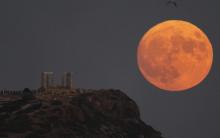Observational astronomy
Rare supermoon lights up the night sky
The supermoon rises behind the ancient Temple of Poseidon at Cape Sounio, about 70 kilometers south of Athens, Greece on Wednesday. The cosmic curtain rose Wednesday night with the second full moon of the month. It is a supermoon because it's closer to Earth than usual, appearing especially big and bright.
- Read more about Rare supermoon lights up the night sky
- Log in to post comments
Two supermoons in August mean double the stargazing fun
The cosmos is offering up a double feature in August: A pair of supermoons culminating in a rare blue moon.
Catch the first show tomorrow evening as the full moon rises in the southeast, appearing slightly brighter and bigger than normal. That's because it will be closer than usual, just 222,159 miles (357,530 kilometers) away, thus the supermoon label.
Two planets sharing same orbit around their star
Astronomers reported on July 19 the discovery of what could be two planets sharing the same orbit around their star.
They said it's the strongest evidence yet of this bizarre cosmic pairing, long suspected but never proven.
- Read more about Two planets sharing same orbit around their star
- Log in to post comments
Astronomers identify most reflective exoplanet
A scorching hot world where metal clouds rain drops of titanium is the most reflective planet ever observed outside of our Solar System, astronomers said yesterday.
This strange world, which is more than 260 light years from Earth, reflects 80 percent of the light from its host star, according to new observations from Europe's exoplanet-probing Cheops space telescope.
- Read more about Astronomers identify most reflective exoplanet
- Log in to post comments
Why have one ‘impossible’ ring around your world when you could have two?
Earlier this year, astronomers announced that a tiny world beyond Neptune with a diameter about one-third that of Earth's moon possessed a Saturn-like ring that should not be there. It now turns out that there are two such "impossible" rings.
Star visibility eroding rapidly as night sky gets brighter: Study
Light pollution is growing rapidly and in some places the number of stars visible to the naked eye in the night sky is being reduced by more than half in less than 20 years, according to a study released on Jan. 19.
Ancient Martian life may have died out in self-induced climate change
Modern Mars is extremely cold and drier than any desert on Earth, with a very thin atmosphere. But this wasn’t always the case…
The solar system could collapse because of a passing star, scientists predict
The researchers simulated the situation around 3,000 times. In nearly 2,000 of them, 26 ended with the planets smashing into each other…
NASA’s James Webb Space Telescope hit by rock
Though assessments are still continuing, the telescope still appears to be operating well enough
- Read more about NASA’s James Webb Space Telescope hit by rock
- Log in to post comments
Look up at night! Eta Aquarids meteor shower will peak on Friday
Up to 30 shooting stars per hour will light up the night sky in Greece






